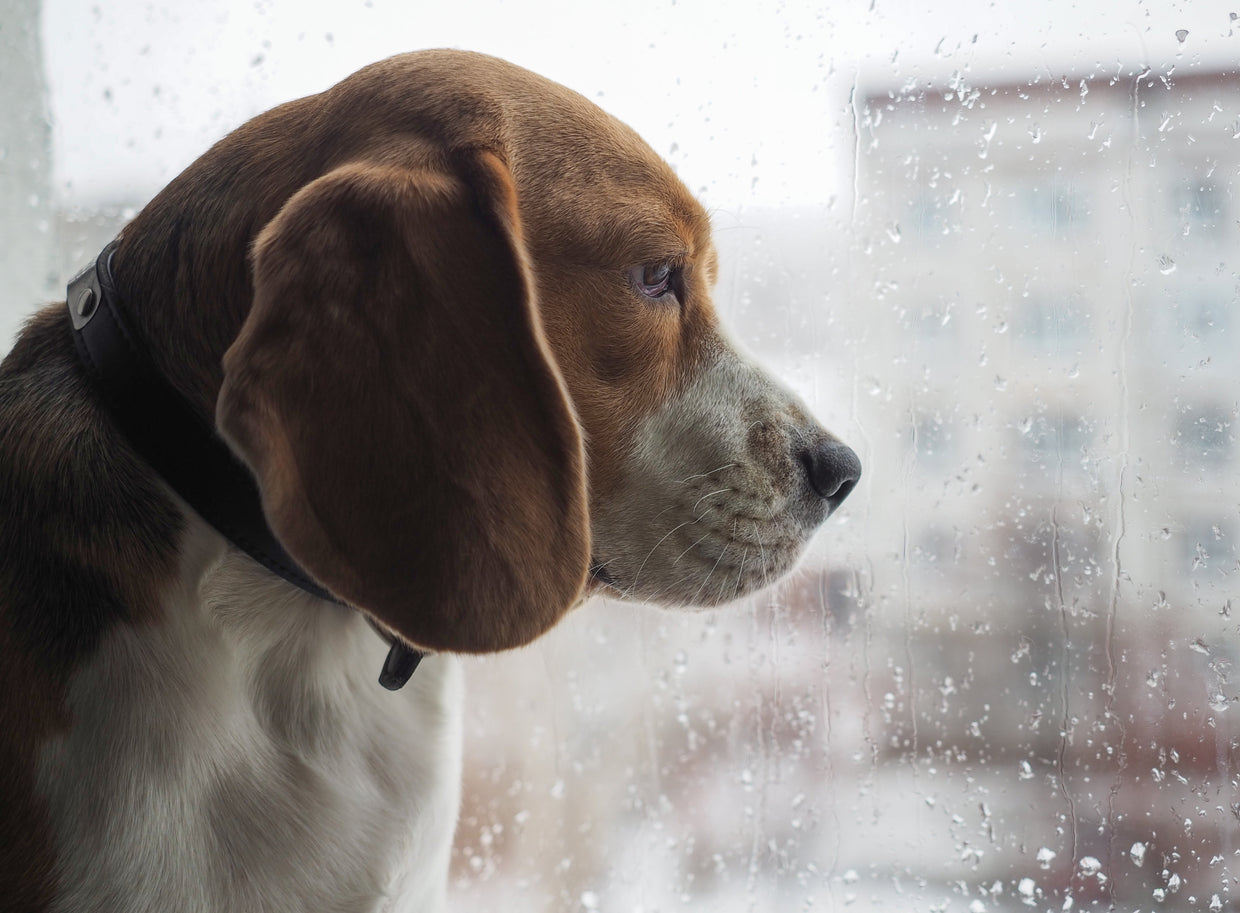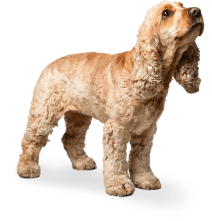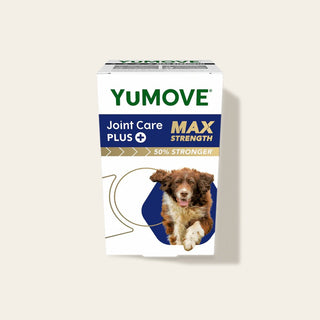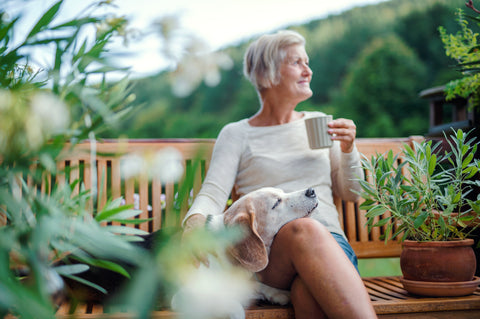

Seasonal Affective Disorder in dogs
Late autumn and early winter means little to no sun and extremely cold temperatures. The lack of sunlight, paired with limited outdoor exercise results in a seasonal depression called Seasonal Affective Disorder (SAD).
We humans can battle seasonal sadness with social activities, UV lights and sunny getaways. Even a cuddle with our canine can help fight the gloom. But can your dog get SAD too? And what can you do to cheer them up? Let’s find out…
What is Seasonal Affective Disorder?
Simply put, it’s a type of depression that’s thought to be caused by a lack of light. Are you losing energy and feeling low during winter? They’re the biggest tell-tale signs of SAD.
Can dogs suffer from Seasonal Affective Disorder?

Just like us, dogs can be affected by the loss of sunlight in winter months. A study by the PDSA found that one-third of dog owners notice the signs of depression in their dogs during the darker months of winter.
Although scientists are still not certain whether dogs truly suffer from Seasonal Affective Disorder, dogs do experience similar symptoms and signs to humans with SAD.
What causes Seasonal Affective Disorder?
Experts aren’t 100% sure, but here are a few of the most likely reasons:
- The seasonal changes paired with the turning back of clocks confuses your dog’s internal body clock. Their body uses sunlight to regulate important tasks (like waking up), and the lack of light can disturb your dog’s everyday rhythm.
- Your dog’s ‘happy hormones’ – like Serotonin and Dopamine – are influenced by the sun, so their production tends to slow down during winter. This means your pup’s more likely to feel gloomy.
- The production of Melatonin has increased. This hormone is responsible for sleepiness, which means dogs with SAD are more likely to feel exhausted or fatigued.
- Some breeds of dog are more vulnerable to SAD as a result of their genetics.
The signs of Seasonal Affective Disorder in dogs
Some things to watch out for in your dog include:
- Withdrawal. Your dog may seem reluctant to play games or do things they usually love, like going for walkies.
- A change to their eating patterns. They might lose their appetite, or start eating more.
- Behavioural changes. Depression can present itself in many ways, it’s not a case of just looking miserable. If they’re suffering from SAD, your dog is more likely to misbehave and do things they wouldn’t normally.
- Lethargy. Your dog is likely to be sleeping much more, but they may be restless – meaning that although they’re sleeping more, they’re not sleeping well.

Is your dog SAD or is it something else?
At this time of the year, it can be easy to pass off your dog’s moodiness as seasonal depression. But did you know that your dog’s mental health can be affected by lots of other things? Here’s just a few issues to watch out for…
-
Changes to their routine
A dog’s life is quite simple. And it’s made up of four basic daily events – eating, sleeping, toileting and exercise. Consistency and routine lets dogs know what to expect in their day-to-day lives. It also helps to keep them less stressed.
Big changes, such as moving house, a new family member (pet or human), and home renovations can leave your dog feeling unsure and nervous. It takes time for your dog to come to terms with these adjustments. The same goes with the turning back of the clocks and the loss of sunlight. Your dog doesn’t understand why these changes have happened, and they can seriously stress them out.
-
Family changes
The bond between a dog and owner is extremely strong. Dogs are sociable animals with pack instincts, so they enjoy being around other animals and humans. That’s why a change to their social dynamic can really upset them. A change in working patterns, divorce, bereavement (whether that’s human or pet), or sometimes even when children leave home can all cause your dog to be stressed. Your furry family member simply doesn’t understand why their favourite people have suddenly disappeared.
-
Boredom
Dogs tend to only go on walks during certain hours of the day. During winter it becomes more difficult to give dogs the exercise that they instinctively need. Dog walks in the dark, icy conditions and the cold weather all make dog walking seem like a chore. As a result, dogs are often left all day with nothing to do.
Bored dogs can be a nuisance. They become prone to naughtiness and attention-seeking behaviour. Plus, boredom can lead to anxiety and depression. That’s why mental stimulation is so important. Make the time to play with your dog. Or, if they’re left alone, provide them with plenty of distractions – such as puzzle feeders, long-lasting chews and plenty of toys.
How to beat the blues

This might all seem a bit doom and gloom, but there’s light at the end of the tunnel. The good news is that SAD in dogs is easily treatable. What’s more, these ‘cures’ are also likely to lift your mood as well:
- Spend some time in the sun. We know what you’re thinking: there is no sunshine during winter. However, leaving your curtains open in the late mornings and early afternoons can bring some daylight into your home. And artificial lighting can trick your dog into thinking it’s summer. Therapy lamps are especially effective in treating SAD.
- Get moving. Even though it might be frosty on that cold December night, your dog will really appreciate some outdoor exercise – even if it’s just half an hour.
- Encourage indoor playtime. If your four-legged friend’s prone to joint stiffness, check out our guide on at-home exercise for stiff dogs.
- Try a multivitamin supplement. Especially one that’s enriched with B Vitamins, Glucosamine and Omega-3 fatty acids.
How Multi-Vitamins can help
Our new range of dog multivitamins have been specifically designed with your dog in mind. These heart-shaped chews are available in three formats: one for vitamins for Adult Dogs, one for vitamins for Young Dogs and another for vitamins for Senior Dogs – with each one tailored to a specific life stage.
They’re packed with all-natural ingredients – like Vitamins C & E, B Vitamins, as well as Salmon Oil, natural antioxidants and Glucosamine. All of these powerful ingredients help with your dog’s skin and coat, joints, digestion, immune system, heart and brain function. What’s more, they’ll also work together to boost your dog’s mood.
Why? It’s because nutrient deficiencies increase feelings of sadness. Nutrition is an extremely important but often overlooked part of mental health. Adding some extra goodness to your dog’s diet can help to not only keep their body active, but their mind healthy.
We hope you found this helpful. Why not take a look at our other behavioural guides – such as ‘Spotting the signs of Dementia in dogs’?



